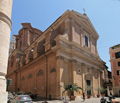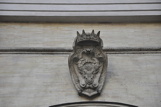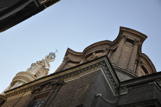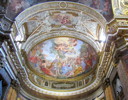Sant'Andrea delle Fratte is a minor basilica, as well as an early 17th century parish, titular and convent church in the rione Colonna, just to the south of the Piazza di Spagna, dedicated to St Andrew the Apostle.
For reference, a plan of the church is available
here.
The first church here was built in the 1192, called infra hortes (later translated into "delle Fratte" or "shrubs") for it was located in a countryside area. The church was given to the Order of Minim of St. Francis of Paola Friars in 1585, and they still serve the parish.
In 1604 the construction of the new church was begun, under the design of Gaspare Guerra. The project halted in 1612 due to lack of funds. He completed the barrel-vaulted nave with narrow chapels on the sides up to the two pillars of the dome toward the aisle, the first level of brick masonry facade. Work was restarted by Francesco Borromini, who was commissioned by the Marchese Paolo del Bufalo to work on the church in the years 1653-1665. Borromini is responsible of the apse, the tambour of the cupola and the fine square campanile with four orders. After his death, the construction was continued by Mattia De Rossi.
By 1686 the Minim fathers commissioned the decoration of the presbytery area, and engaged Pasquale Marini to fresco the dome and the spherical vault of the apse, and Lazzaro Baldi, Giovan Battista Lenardi, and Francesco Trevisani to paint three large altarpieces with Stories of St. Andrew, to decorate the apse walls. The façade was only completed in 1826 by Pasquale Belli, and the marble floor was constructed in 1828.
In 1842, a young French Jew named Alphonse Ratisbonne had a sudden and unexpected vision of the Virgin of the Miraculous Medal at the church, which led him to convert to the Catholic Church.




































































